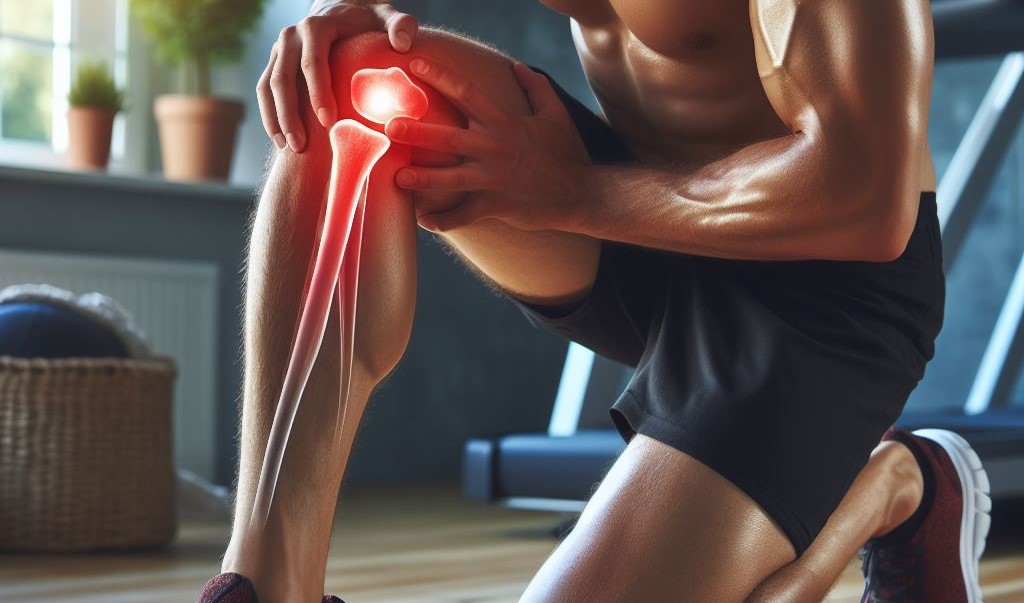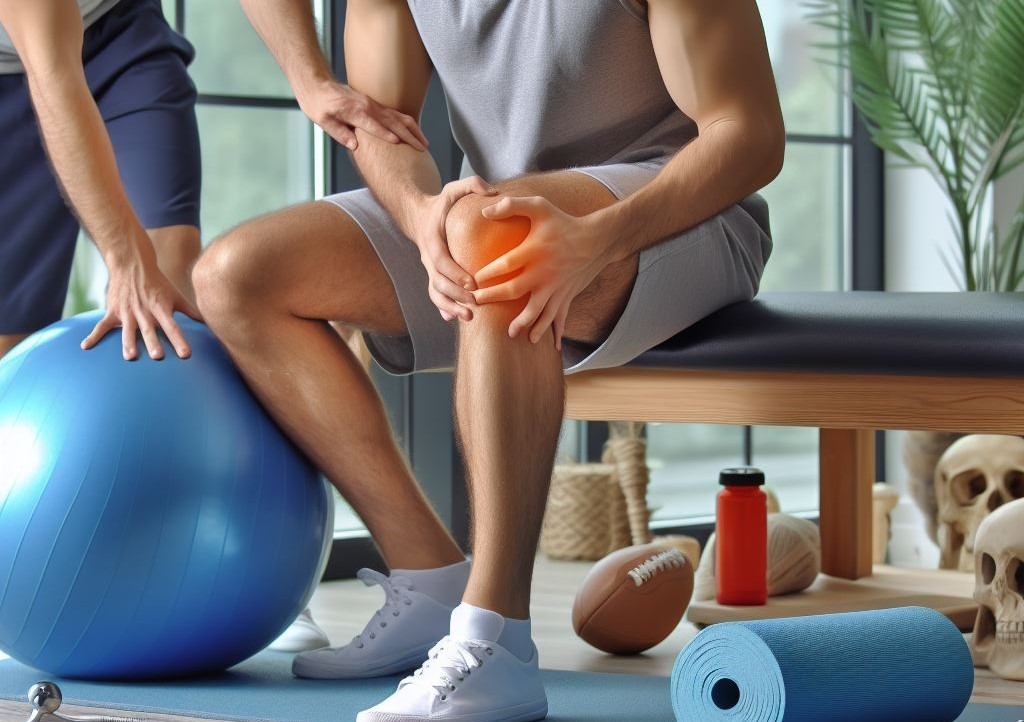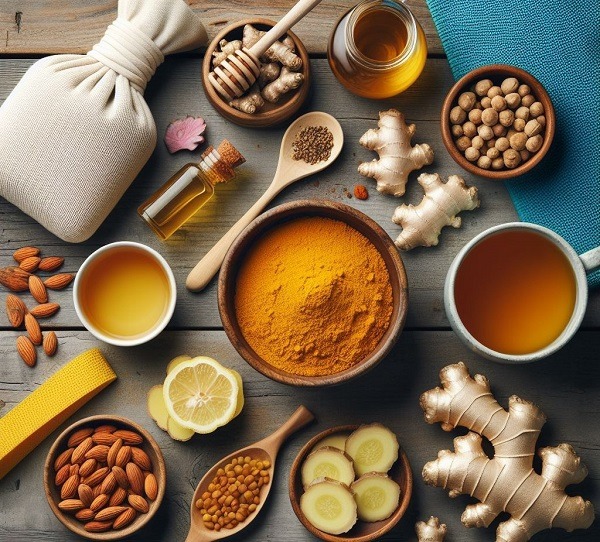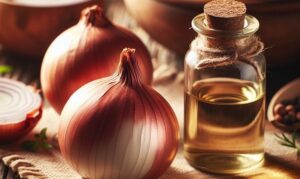If you’ve ever experienced knee pain, you know how debilitating it can be. It can make simple tasks like walking or climbing stairs feel like daunting challenges. Many people believe that knee pain is just a part of getting older or a result of an injury that requires medication or surgery to fix. In this guide, we’ll explore how to treat knee pain naturally which can provide fast relief.
Understanding Knee Pain
Knee pain can stem from a variety of factors, including injuries, overuse, or underlying medical conditions like arthritis. It’s essential to understand the root cause of your knee pain to effectively manage and treat it. Common types of knee pain include:
- Osteoarthritis: This degenerative joint disease occurs when the protective cartilage that cushions the ends of your bones wears down over time, leading to pain and stiffness.
- Tendonitis: Inflammation or irritation of the tendons surrounding the knee joint can cause pain, especially with movement.
- Bursitis: Inflammation of the bursae, small sacs of fluid that cushion the knee joint, can result in pain and swelling.
- Injuries: Sprains, strains, or tears of the ligaments, tendons, or meniscus in the knee can cause acute or chronic pain.
Five Major Causes of Knee Pain
Let’s explore five major factors that can contribute to knee pain and how to address them and then find how to treat knee pain naturally.
1. Osteoarthritis:
Osteoarthritis is the most common form of arthritis and a leading cause of knee pain, especially in older adults. This degenerative joint disease occurs when the protective cartilage that cushions the ends of the bones wears down over time, leading to pain, stiffness, and swelling in the knee joint.
Addressing Osteoarthritis:
- Maintain a healthy weight to reduce stress on the knees.
- Incorporate low-impact exercises like swimming and cycling to strengthen the muscles around the knee joint.
- Use assistive devices like braces or walking aids to support the knee and reduce pain during activities.
2. Ligament Injuries:
Injuries to the ligaments in the knee, such as the ACL (anterior cruciate ligament) or MCL (medial collateral ligament), can cause severe pain and instability. These injuries often occur during sports or activities that involve sudden changes in direction or impact.
Addressing Ligament Injuries:
- Rest and ice the affected knee to reduce swelling and inflammation.
- Wear a brace or supportive wrap to stabilize the knee and prevent further injury.
- Physical therapy exercises to strengthen the muscles around the knee and improve stability.
3. Meniscus Tears:
The meniscus is a rubbery, C-shaped disc that cushions the knee joint and helps distribute weight evenly. Tears in the meniscus can occur due to sudden twists or repetitive stress, leading to pain, swelling, and stiffness in the knee.
Addressing Meniscus Tears:
- Rest and avoid activities that exacerbate pain and discomfort.
- Physical therapy exercises to strengthen the muscles around the knee and improve flexibility.
- In severe cases, surgery may be necessary to repair or remove the torn meniscus.
4. Patellar Tendonitis:
Patellar tendonitis, also known as jumper’s knee, is a common overuse injury that affects the tendon connecting the kneecap (patella) to the shinbone. This condition often occurs in athletes who participate in sports that involve jumping or repetitive knee movements.
Addressing Patellar Tendonitis:
- Rest and avoid activities that aggravate the pain, such as jumping or squatting.
- Apply ice to the affected area to reduce pain and inflammation.
- Stretching and strengthening exercises to improve flexibility and support the knee joint.
5. Bursitis: Inflammation and Irritation
Bursitis is the inflammation of the bursae, small fluid-filled sacs that cushion the knee joint and reduce friction between tissues. It can occur due to overuse, trauma, or underlying conditions like arthritis, leading to pain, swelling, and tenderness in the knee.
Addressing Bursitis:
- Rest and avoid activities that put pressure on the knee joint.
- Apply ice to the affected area to reduce swelling and discomfort.
- Anti-inflammatory medications or corticosteroid injections may be prescribed to alleviate pain and inflammation.
Also read: Causes of Pimple at Roof of Mouth
Natural Remedies for Knee Pain
Let’s dive into some effective ways to find relief without reaching for the medicine cabinet and learn how to treat knee pain naturally.
Home Remedies
When your knees are giving you grief, sometimes all you need is a little TLC from the comfort of your own home. Here are a few tried-and-true home remedies to help soothe your aching knees:
- Hot and Cold Therapy: Grab a bag of frozen peas or a heating pad and apply it to your sore knee. Alternating between hot and cold treatments can help reduce inflammation and alleviate pain. Plus, it feels pretty darn good.
- Elevation: Give your knees a break by propping them up on a couple of pillows. Elevating your legs can help reduce swelling and promote circulation, giving your knees the rest they deserve.
- Rest: Sometimes the best remedy is the simplest one. If your knees are screaming at you, listen to them! Take a break from activities that aggravate the pain and give your knees some well-deserved rest.
- Compression: Wrapping your knee with a compression bandage can help reduce swelling and provide support. Just be sure not to wrap it too tightly, as this can impede circulation.
- Essential Oils: Certain essential oils, like peppermint and lavender, have analgesic and anti-inflammatory properties that can help relieve knee pain. Dilute a few drops of oil in a carrier oil, such as coconut or jojoba oil, and massage it into your knee for soothing relief.
- Epsom Salt Soak: Soaking your knees in a warm bath with Epsom salt can help relax your muscles and ease discomfort. Plus, the magnesium in Epsom salt is thought to have anti-inflammatory properties that can aid in pain relief.
Also read: Home Remedies For Carpal Tunnel
Herbal Treatments
Nature has provided us with an abundance of herbs and botanicals that can work wonders for knee pain relief. Here are a couple of herbal remedies to consider adding to your arsenal:
- Turmeric: This golden spice isn’t just delicious in curry – it’s also a powerful anti-inflammatory that can help reduce swelling and ease joint pain. Try adding turmeric to your meals or taking it in supplement form for an extra boost of relief.
- Ginger: Not just for upset stomachs, ginger is also a potent anti-inflammatory that can help soothe sore muscles and joints. Brew yourself a cup of ginger tea or add fresh ginger to your favorite recipes for a natural way to combat knee pain.
- Cayenne Pepper: Believe it or not, cayenne pepper contains a compound called capsaicin, which has been shown to help relieve pain when applied topically. Mix a small amount of cayenne pepper with olive oil to create a homemade pain-relieving cream, and apply it to your knees as needed.
- Arnica: Arnica is a flowering plant that has been used for centuries to treat bruises, sprains, and muscle soreness. You can find arnica gel or cream at most health food stores, and applying it to your knees can help reduce pain and inflammation.
- Boswellia: Also known as Indian frankincense, boswellia is a resin that has been used in traditional Ayurvedic medicine for centuries to treat inflammatory conditions like arthritis. Taking Boswellia supplements or using Boswellia cream may help alleviate knee pain and improve mobility.
- White Willow Bark: White willow bark contains a compound called salicin, which is similar to aspirin and has been shown to have pain-relieving and anti-inflammatory effects. You can brew white willow bark tea or take it in supplement form to help ease knee pain.
Also read: Herbal Remedies For Tooth Abscess
Lifestyle Changes
Sometimes the key to relieving knee pain is making a few simple tweaks to your daily routine. Here are some lifestyle changes that can make a big difference:
- Maintain a Healthy Weight: Carrying around extra pounds puts added stress on your knees, exacerbating pain and inflammation. By maintaining a healthy weight through diet and exercise, you can ease the burden on your knees and reduce discomfort.
- Proper Footwear: The shoes you wear can have a big impact on your knee health. Opt for supportive, cushioned shoes that provide stability and shock absorption to help reduce strain on your knees.
- Posture Matters: Believe it or not, your posture can affect your knee health. Practice good posture by standing and sitting up straight, engaging your core, and avoiding slouching. This can help distribute weight more evenly and alleviate pressure on your knees.
- Low-Impact Exercise: Incorporating low-impact exercises like swimming, biking, or walking into your routine can help strengthen the muscles around your knees and improve joint stability without putting undue stress on them.
- Stretching and Flexibility: Regular stretching can help improve flexibility and range of motion in your knees, reducing the risk of injury and easing discomfort. Focus on stretching the quadriceps, hamstrings, and calves to support healthy knee function.
- Mindful Movement: Pay attention to your body and avoid activities that cause pain or discomfort in your knees. Listen to your body’s signals and modify your movements as needed to protect your joints and prevent further injury.
Incorporating these natural remedies and lifestyle changes into your daily routine can help you find relief from knee pain and get back to doing the things you love.
Also read: Natural Treatments for Yellowing On Roof Of Mouth
Exercise and Physical Therapy
Let’s explore some effective exercises and therapies to help you strengthen your knees naturally.
Knee Strengthening Exercises
- Quad Sets: Sit on the floor with your legs extended and tighten the muscles on the top of your thigh (quadriceps). Hold for a few seconds, then relax. Repeat 10-15 times. This exercise helps stabilize the knee joint and improve knee function.
- Hamstring Curls: Stand behind a chair or hold onto a countertop for support. Bend one knee and bring your heel towards your buttocks, then lower it back down. Repeat on the other side. Aim for 10-15 repetitions on each leg. Hamstring curls strengthen the muscles at the back of the thigh, which support the knee joint.
- Leg Raises: Lie on your back with one leg bent and the other straight. Lift the straight leg off the ground, keeping it straight and in line with your body. Hold for a few seconds, then lower it back down. Switch legs and repeat. Perform 10-15 repetitions on each side. Leg raises target the quadriceps and hip flexors, improving knee stability and function.
- Step-Ups: Stand in front of a step or sturdy platform. Step up with one foot, then bring the other foot up to meet it. Step back down and repeat on the other side. Aim for 10-15 repetitions on each leg. Step-ups strengthen the quadriceps, glutes, and hamstrings, promoting better balance and stability in the knees.
- Calf Raises: Stand with your feet hip-width apart and rise onto your toes, lifting your heels off the ground. Hold for a few seconds, then lower back down. Repeat 10-15 times. Calf raises target the muscles in the calves and ankles, which play a crucial role in supporting the knees during movement.
Also read: Perfect Morning Weekend Routine (2024)
Physical Therapy Techniques
- Massage Therapy: Massage can help reduce muscle tension, improve circulation, and promote healing in the knee area. A skilled massage therapist can target specific muscles and soft tissues to alleviate pain and improve mobility.
- Acupuncture: This ancient Chinese therapy involves inserting thin needles into specific points on the body to stimulate energy flow and promote healing. Acupuncture is effective in relieving knee pain and improving joint function.
- Ultrasound Therapy: Ultrasound uses sound waves to generate heat deep within the tissues, promoting circulation and reducing inflammation. This non-invasive therapy can help alleviate pain and stiffness in the knees, making movement easier and more comfortable.
- Electrical Stimulation: Also known as TENS (transcutaneous electrical nerve stimulation), this therapy involves delivering mild electrical impulses to the nerves in the knee area, which can help block pain signals and reduce discomfort.
- Hydrotherapy: Water-based exercises and therapies, such as swimming or aquatic aerobics, can provide gentle yet effective conditioning for the muscles around the knees without putting undue stress on the joints. Hydrotherapy can improve strength, flexibility, and overall joint health.
Incorporating these knee-strengthening exercises and physical therapy techniques into your routine can help you build a strong foundation for healthy, pain-free knees.
Also read: Natural Care of Roof Of My Mouth Swollen
Nutrition and Supplements
Let’s explore some key nutritional strategies and supplements to keep your knees happy and healthy.
Anti-inflammatory Diet
- Omega-3 Fatty Acids: Incorporate sources of omega-3 fatty acids into your diet, such as fatty fish (salmon, mackerel, sardines), flaxseeds, chia seeds, and walnuts. Omega-3s have potent anti-inflammatory properties that can help reduce inflammation in the body, including the knees.
- Colorful Fruits and Vegetables: Load up on fruits and vegetables rich in antioxidants and phytonutrients, such as berries, leafy greens, bell peppers, and sweet potatoes. These vibrant foods help combat oxidative stress and inflammation, promoting joint health and reducing knee pain.
- Healthy Fats: Include sources of healthy fats in your diet, such as avocado, olive oil, nuts, and seeds. Healthy fats are essential for lubricating joints and reducing inflammation, providing crucial support for knee health.
- Whole Grains: Opt for whole grains like quinoa, brown rice, oats, and barley instead of refined grains. Whole grains are rich in fiber and nutrients that support overall health and may help reduce inflammation in the body, including the knees.
- Spices and Herbs: Add flavor and anti-inflammatory benefits to your meals with spices and herbs like turmeric, ginger, garlic, and cinnamon. These culinary treasures not only enhance the taste of your dishes but also provide potent anti-inflammatory and antioxidant properties.
Also read: Nutritional Facts of Garlic Bread
Supplements for Joint Health
- Glucosamine: Glucosamine is a compound naturally found in the body that plays a key role in building and maintaining cartilage. Taking glucosamine supplements may help support joint health and reduce symptoms of knee osteoarthritis, such as pain and stiffness.
- Chondroitin: Chondroitin is another natural compound found in cartilage that helps maintain its structure and elasticity. Like glucosamine, chondroitin supplements may help alleviate knee pain and improve joint function in individuals with osteoarthritis.
- Fish Oil: Fish oil supplements, rich in omega-3 fatty acids EPA and DHA, have been shown to have anti-inflammatory effects and may help reduce joint pain and stiffness in individuals with inflammatory conditions like rheumatoid arthritis.
- Vitamin D: Adequate vitamin D levels are essential for bone health and may play a role in reducing the risk of osteoarthritis and other joint disorders. Consider taking a vitamin D supplement, especially if you have limited sun exposure or are at risk of deficiency.
- Turmeric/Curcumin: Curcumin, the active compound in turmeric, has potent anti-inflammatory and antioxidant properties that may help reduce knee pain and improve joint function in individuals with osteoarthritis. Look for supplements standardized to contain high levels of curcumin for maximum benefit.
Incorporating these dietary strategies and supplements into your routine can help support healthy knees and reduce the risk of joint pain and inflammation.
Also read: Causes Of Crunching Sound In Neck
Remember to consult with a healthcare professional before starting any new supplement regimen, especially if you have underlying health conditions or are taking medications.
Conclusion
By incorporating the tips and strategies outlined in this guide on how to treat knee pain naturally, you’re well on your way to finding lasting relief and improving your overall quality of life. Remember, finding relief from knee pain is not a one-size-fits-all approach. Discovering which remedies and strategies work best for you may take some trial and error. Be patient with yourself and listen to your body’s cues along the way.
Frequently Asked Questions (FAQs)
Here are some questions.
Is knee pain a normal part of aging?
While it’s true that many people experience knee pain as they get older, it’s not necessarily a normal part of aging. Knee pain can be caused by a variety of factors, including injury, overuse, and underlying medical conditions like arthritis.
How do I know if I need to see a doctor for my knee pain?
It’s always a good idea to see a doctor if you’re experiencing persistent or severe knee pain, especially if it’s interfering with your daily activities or quality of life. They can help diagnose the underlying cause of your knee pain and recommend appropriate treatment options.
Can losing weight help with knee pain?
Yes, losing weight can help reduce knee pain, especially if you’re carrying extra pounds. Excess weight puts added stress on the knees, exacerbating pain and inflammation. By maintaining a healthy weight through diet and exercise, you can ease the burden on your knees and improve overall joint health.








